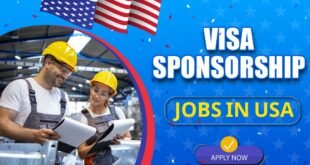What types of Visa Sponsorship?
For many international professionals and immigrants, working in the United States represents a dream and a significant career milestone. To make that dream a reality, securing visa sponsorship is often essential. Visa sponsorship is a critical process where a U.S. employer or family member petitions the U.S. government to grant a visa to a foreign national. This sponsorship legally permits the foreign national to live and work in the U.S. It’s an involved process that depends on visa type, eligibility, and employer requirements.
In today’s globalized economy, U.S. companies are actively seeking talent from across the world, offering multiple types of visa sponsorships. Whether you’re a skilled IT worker, an academic researcher, or seeking seasonal agricultural work, there’s likely a visa sponsorship category that fits your profile. Understanding these options is the first step to landing a U.S. job with visa support.
Types of Visa Sponsorship
Employment-based Visa Sponsorship Process
U.S. employers can sponsor foreign nationals under employment-based visa categories. This process involves the employer petitioning the U.S. Citizenship and Immigration Services (USCIS) and sometimes acquiring certification from the U.S. Department of Labor.
Key steps in employment-based sponsorship include:
- Job Offer: A formal offer must be extended to the foreign worker.
- Labor Certification (if applicable): For certain visas (like EB-2 or EB-3), the employer must prove that no qualified U.S. workers are available for the position.
- Filing Form I-140 (Immigrant Petition for Alien Worker): This is done for green card-based sponsorships.
- Filing Form I-129 (Non-immigrant worker): Used for temporary work visas like H-1B, L-1, etc.
Family-based Sponsorship
Family-based sponsorship allows U.S. citizens and lawful permanent residents to bring close relatives to the U.S. This is not employment-based, but it’s an essential part of immigration.
Common family-sponsored visas:
- Immediate Relatives: Includes spouse, children under 21, and parents of U.S. citizens.
- Family Preference Categories: Brothers, sisters, and married children of U.S. citizens or green card holders.
Unskilled Jobs with Visa Sponsorship
Not all visa sponsorships require advanced degrees or specialized skills. Some U.S. industries offer opportunities for unskilled or low-skilled foreign workers.
Examples of unskilled jobs with visa sponsorship:
- Agricultural Workers (H-2A visa)
- Hospitality Workers (H-2B visa)
- Caregivers and Home Health Aides
- Construction Laborers
These roles often offer seasonal or temporary visas and sometimes lead to permanent residency pathways.
Types of Work Visas in the USA
There are multiple visa types depending on the nature of the job, qualifications, and duration of stay.
Most popular U.S. work visas include:
- H-1B Visa: For skilled professionals (tech, engineering, finance)
- L-1 Visa: For intracompany transferees
- O-1 Visa: For individuals with extraordinary ability
- TN Visa: For Canadian and Mexican professionals (under NAFTA/USMCA)
- H-2A Visa: Seasonal agricultural workers
- H-2B Visa: Non-agricultural temporary workers
- EB Visas (EB1, EB2, EB3): Employment-based green cards
Eligibility Requirements for Sponsoring a Work Visa in the USA
U.S. employers must meet specific criteria to legally sponsor a worker:
- Be a legitimate U.S.-based business entity
- Offer a job that qualifies under USCIS regulations
- Prove the job cannot be filled by a U.S. citizen or resident
- Pay prevailing wages as required by the Department of Labor
- File the correct forms with required fees and documentation
How can I get Sponsorship for a US Work Visa?
- Identify Your Skills: Choose jobs that match your qualifications and visa categories (e.g., H-1B for engineers, H-2B for hospitality).
- Target Employers that Sponsor: Focus on U.S. companies with a history of sponsoring visas (check sites like myvisajobs.com).
- Optimize Your Resume for U.S. Standards: Include clear job roles, education, and visa status (if applicable).
- Apply Early: Visa quotas (especially H-1B) fill up quickly each year.
- Use Global Job Boards: LinkedIn, Indeed, Glassdoor, and company career pages often list “visa sponsorship available” roles.
How much does US Work Visa Sponsorship Cost?
The cost of sponsoring a U.S. work visa varies depending on the visa type:
| Visa Type | Employer Fees | Employee Fees | Total Estimated Cost |
| H-1B | $1,710 – $6,460 | $190 – $500 | $2,000 – $7,000+ |
| L-1 | $460 – $4,500 | $190 | $1,000 – $5,000+ |
| O-1 | $460 – $2,500 | $190 | $1,000 – $3,000+ |
| EB Visas | $700 – $2,000 | $345 – $1,140 | $2,000 – $5,000+ |
Note: Many reputable employers cover the majority or all of the sponsorship fees.
Different Types of U.S. Work Visas
- Non-Immigrant Visas (Temporary):
- H-1B, L-1, H-2A, H-2B, O-1, TN
- H-1B, L-1, H-2A, H-2B, O-1, TN
- Immigrant Visas (Permanent residency/Green card):
- EB-1: Priority workers
- EB-2: Advanced degree professionals
- EB-3: Skilled/unskilled workers
- EB-1: Priority workers
Eligibility Requirements
Common criteria include:
- Valid job offer from a U.S. employer
- Meet educational and experience requirements
- English proficiency (in some cases)
- Clean criminal background
- Relevant credentials (licenses, degrees, certifications)
Finding Visa Sponsorship Jobs
Strategies to find U.S. visa sponsorship jobs:
- Use sites like:
- MyVisaJobs
- H1Bdata.info
- USCIS H-1B Employers Data Hub
- MyVisaJobs
- Target multinational companies like:
- Google, Amazon, Microsoft, IBM, Deloitte
- Google, Amazon, Microsoft, IBM, Deloitte
- Apply via internship or training programs (like CPT/OPT)
- Attend virtual U.S. job fairs for international candidates
H1B Visa Sponsorship Jobs
High-demand sectors for H-1B visa include:
- Information Technology (IT)
- Data Science & Artificial Intelligence
- Engineering
- Healthcare & Medical
- Finance & Accounting
- University-level teaching & research
Visa Sponsorship Process for Employers
- Job posting and candidate selection
- Labor Condition Application (LCA) – DOL
- Petition filing with USCIS (Form I-129 or I-140)
- Candidate applies for visa at U.S. embassy/consulate
- Visa stamping and travel to U.S.
Types of Visa Sponsorship Can I get from a US Company? (Table Format)
| Sponsorship Type | Description | Visa Category | Duration |
| Temporary Work Visa | For specialized or seasonal workers | H-1B, H-2A, H-2B | 1-6 years |
| Permanent Residency | For skilled workers & professionals | EB1, EB2, EB3 | Green Card |
| Intra-company Transfer | For relocating foreign staff to U.S. branches | L-1A, L-1B | 1-7 years |
| Extraordinary Talent | For individuals with exceptional ability | O-1, EB1 | 3 years + |
| NAFTA/USMCA Visas | For Canadian and Mexican professionals | TN Visa | 1-3 years |
| Optional Practical Training | For F-1 visa students after graduation | OPT, STEM OPT | 12–36 months |
| Training/Internship | For non-specialized or student-related training roles | J-1 Visa | 12–24 months |
| Visa Type | Description | Duration | Sponsorship Required? |
| H-1B | Specialty occupation | Up to 6 years | Yes |
| L-1 | Intracompany transfer | Up to 7 years | Yes |
| O-1 | Extraordinary ability | Up to 3 years (renewable) | Yes |
| TN | Canadian/Mexican professionals | 3 years (renewable) | Yes |
| H-2A | Temporary agricultural | Up to 1 year (renewable) | Yes |
| H-2B | Temporary non-agricultural | Up to 1 year (renewable) | Yes |
| EB-1 | Priority workers (green card) | Permanent | Yes |
| EB-2 | Advanced degree/exceptional ability | Permanent | Yes |
| EB-3 | Skilled/unskilled workers | Permanent | Yes |
| J-1 | Exchange visitor | Varies | Yes (by program sponsor) |
| F-1 OPT/CPT | Student work authorization | Up to 3 years (STEM OPT) | No (but job offer required) |
Employer Responsibilities Work Visa in the USA
U.S. employers sponsoring a work visa have important legal obligations:
- Provide legitimate job offer
- Pay the prevailing wage
- Ensure compliance with U.S. labor laws
- Cover visa fees (in most cases)
- Notify USCIS of job or employment changes
- Maintain documentation for audit purposes
- Avoid discrimination against U.S. workers
Failure to meet these responsibilities can result in fines, audits, and disqualification from future sponsorship privileges.
Sponsorship Letter for Visa
A Sponsorship Letter is an official document from a U.S. employer or family sponsor affirming their intent to support the visa applicant.
Key elements:
- Employer’s letterhead
- Job title and description
- Duration of employment
- Salary offer
- Statement of visa sponsorship
- Contact details
EB1 Visa
EB1 is a first-preference employment-based green card for individuals with:
- Extraordinary ability in arts, science, education, or athletics
- Outstanding professors and researchers
- Multinational managers or executives
No labor certification is required, making EB1 faster than other immigrant visas.
L1 Visa
L1 is a non-immigrant visa for employees of international companies being transferred to a U.S. office.
- L-1A: Managers and executives (valid up to 7 years)
- L-1B: Specialized knowledge workers (valid up to 5 years)
Spouses and children can accompany under L-2 visas, and spouses may work in the U.S.
Working in the United States
Working legally in the U.S. with visa sponsorship provides not only income but access to long-term residency opportunities, family immigration benefits, and eventual citizenship in some cases.
Benefits include:
- Competitive salaries and global career exposure
- Employer-sponsored health insurance
- Pathways to permanent residency
- Quality of life and educational opportunities for dependents
Apply for USA VISA Sponsorship
To apply for visa sponsorship from a U.S. company:
- Find the right job with an employer who sponsors
- Secure a job offer and confirm sponsorship availability
- Ensure your qualifications match visa criteria
- Work with your employer on required USCIS paperwork
- Attend a U.S. embassy interview and receive visa stamp
- Enter the U.S. and begin your employment legally
 AWE Credits Free VISA Consultancy Service in USA, UK, UAE, CANADA, Australia
AWE Credits Free VISA Consultancy Service in USA, UK, UAE, CANADA, Australia

